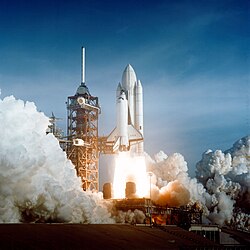The
V-2 (
German:
Vergeltungswaffe 2, "Vengeance Weapon 2"), technical name
Aggregat-4 (A4), was the world's first long-range
ballistic missile. It was developed during the
Second World War in
Germany, specifically targeted at
London and later
Antwerp.
Commonly referred to as the V-2 rocket, the liquid-propellant rocket was a combat-ballistic missile, now considered short-range, and first known human artifact to enter outer space. It was the progenitor of all modern rockets, including those used by the United States and Soviet Union's space programs. During the aftermath of World War II the American, Soviet and British governments all gained access to the V-2's technical designs as well as the actual German scientists responsible for creating the rockets, via Operation Paperclip, Operation Osoaviakhim and Operation Backfire respectively.
The weapon was presented by Nazi propaganda as a retaliation for the bombers that attacked ever more German cities from 1942 until Germany surrendered.
Beginning in September 1944, over 3,000 V-2s were launched as military rockets by the German Wehrmacht against Allied targets during the war, mostly London and later Antwerp and Liège. According to a BBC documentary in 2011, the attacks resulted in the deaths of an estimated 9,000 civilians and military personnel, while 12,000 forced labourers and concentration camp prisoners were killed producing the weapons.
Gerard Kitchen O'Neill (February 6, 1927 – April 27, 1992) was an
American physicist and space activist. A faculty member of
Princeton University, he invented a device called the
particle storage ring for high-energy physics experiments. Later, he invented a magnetic launcher called the
mass driver. In the 1970s, he developed a plan to build human settlements in outer space, including a
space habitat design known as the
O'Neill cylinder. He founded the
Space Studies Institute, an organization devoted to funding research into
space manufacturing and
colonization.
O'Neill began researching high-energy particle physics at Princeton in 1954 after he received his doctorate from Cornell University.
Two years later, he published his theory for a particle storage ring. This invention allowed particle physics experiments at much higher energies than had previously been possible. In 1965 at Stanford University, he performed the first colliding beam physics experiment.
While teaching physics at Princeton, O'Neill became interested in the possibility that humans could live in outer space. He researched and proposed a futuristic idea for human settlement in space, the O'Neill cylinder, in "The Colonization of Space", his first paper on the subject. He held a conference on space manufacturing at Princeton in 1975. Many who became post-Apollo-era space activists attended. O'Neill built his first mass driver prototype with professor Henry Kolm in 1976. He considered mass drivers critical for extracting the mineral resources of the Moon and asteroids. His award-winning book The High Frontier: Human Colonies in Space inspired a generation of space exploration advocates. He died of leukemia in 1992.




























